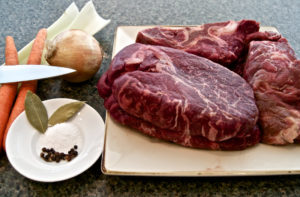What You Need to Know about Foodborne Illnesses
While the American food supply is among the safest in the world, the Federal government estimates that there are about 48 million cases of foodborne illness annually — the equivalent of sickening 1 in 6 Americans each year. And each year these illnesses result in an estimated 128 000 hospitalizations and 3 000 deaths.

Foodborne Illnesses
The chart below includes foodborne disease-causing organisms that frequently cause illness in the United States. As the chart shows, the threats are numerous and varied, with symptoms ranging from relatively mild discomfort to very serious,life-threatening illness. While the very young, the elderly, and persons with weakened immune systems are at greatest risk of serious consequences from most foodborne illnesses, some of the organisms shown below pose grave threats to all persons.
Organism |
Common Name of Illness |
Onset Time After Ingesting |
Signs & Symptoms |
Duration |
Food Sources |
Bacillus cereus |
B. cereus food poisoning |
10-16 hrs |
Abdominal cramps, watery diarrhea, nausea |
24-48 hours |
Meats, stews, gravies, vanilla sauce |
Campylobacter jejuni |
Campylobacteriosis |
2-5 days |
Diarrhea, cramps, fever, and vomiting; diarrhea may be bloody |
2-10 days |
Raw and undercooked poultry, unpasteurized milk,contaminated water |
Clostridium |
Botulism |
12-72 hours |
Vomiting, diarrhea, blurred vision, double vision, difficulty in swallowing, muscle weakness. Can result in respiratory failure and death |
Variable |
Improperly canned foods, especially home-canned vegetables, fermented fish, baked potatoes in aluminum foil |
Clostridium |
Perfringens food |
8–16 hours |
Intense abdominal cramps, watery diarrhea |
Usually 24 |
Meats, poultry, gravy, dried or precooked foods, time and/or temperature-abused foods |
Cryptosporidium |
Intestinal |
2-10 days |
Diarrhea (usually watery), stomach cramps, upset stomach, slight fever |
May be remitting and relapsing over weeks to months |
Uncooked food or food contaminated by an ill food handler after cooking, contaminated drinking water |
Cyclospora |
Cyclosporiasis |
1-14 days, usually at least 1 week |
Diarrhea (usually watery), loss of appetite, substantial loss of weight, stomach cramps, nausea, vomiting, fatigue |
May be remitting and relapsing over weeks to months |
Various types of fresh produce (imported berries, lettuce, basil) |
E. coli |
E. coli infection |
1-3 days |
Watery diarrhea, abdominal cramps, some vomiting |
3-7 or more days |
Water or food contaminated with human feces |
E. coli O157:H7 |
Hemorrhagic colitis |
1-8 days |
Severe (often bloody) diarrhea, abdominal pain and vomiting. Usually, little or no fever is present. More common in children 4 years or younger. Can lead to kidney failure. |
5-10 days |
Undercooked beef (especially hamburger), unpasteurized milk and juice, raw fruits and vegetables (e.g. sprouts), and contaminated water |
Hepatitis A |
Hepatitis |
28 days average (15-50 days) |
Diarrhea, dark urine, jaundice, and flu-like symptoms, i.e., fever, headache, nausea, and abdominal pain |
Variable, 2 weeks-3 months |
Raw produce, contaminated drinking water, uncooked foods and cooked foods that are not reheated after contact with an infected food handler; shellfish from contaminated waters |
Listeria |
Listeriosis |
9-48 hrs for gastro-intestinal symptoms, 2-6 weeks for invasive disease |
Fever, muscle aches, and nausea or diarrhea. Pregnant women may have mild flu-like illness, and infection can lead to premature delivery or stillbirth. The elderly or immunocompromised patients may develop bacteremia or meningitis. |
Variable |
Unpasteurized milk, soft cheeses made with unpasteurized milk, ready-to-eat deli meats |
Noroviruses |
Variously called viral gastroenteritis, winter diarrhea, acute non- bacterial gastroenteritis, food poisoning, and food infection |
12-48 hrs |
Nausea, vomiting, abdominal cramping, diarrhea, fever, headache. Diarrhea is more prevalent in adults, vomiting more common in children. |
12-60 hrs |
Raw produce, contaminated drinking water, uncooked foods and cooked foods that are not reheated after contact with an infected food handler; shellfish from contaminated waters |
Salmonella |
Salmonellosis |
6-48 hours |
Diarrhea, fever, abdominal cramps, vomiting |
4-7 days |
Eggs, poultry, meat, unpateurized milk or juice, cheese, contaminated raw fruits and vegetables |
Shigella |
Shigellosis or Bacillary dysentery |
4-7 days |
Abdominal cramps, fever, and diarrhea. Stools may contain blood and mucus. |
24-48 hrs |
Raw produce, contaminated drinking water, uncooked foods and cooked foods that are not reheated after contact with an infected food handler |
Staphylococcus aureus |
Staphylococcal food poisoning |
1-6 hours |
Sudden onset of severe nausea and vomiting. Abdominal cramps. Diarrhea and fever may be present. |
24-48 hours |
Unrefrigerated or improperly refrigerated meats, potato and egg salads, cream pastries |
Vibrio |
V. parahaemolyticusinfection |
4-96 hours |
Watery (occasionally bloody) diarrhea, abdominal cramps, nausea, vomiting, fever |
2-5 days |
Undercooked or raw seafood, such as shellfish |
Vibrio vulnificus |
V. vulnificusinfection |
1-7 days |
Vomiting, diarrhea, abdominal pain, bloodborne infection. Fever, bleeding within the skin, ulcers requiring surgical removal. Can be fatal to persons with liver disease or weakened immune systems. |
2-8 days |
Undercooked or raw seafood, such as shellfish (especially oysters) |












